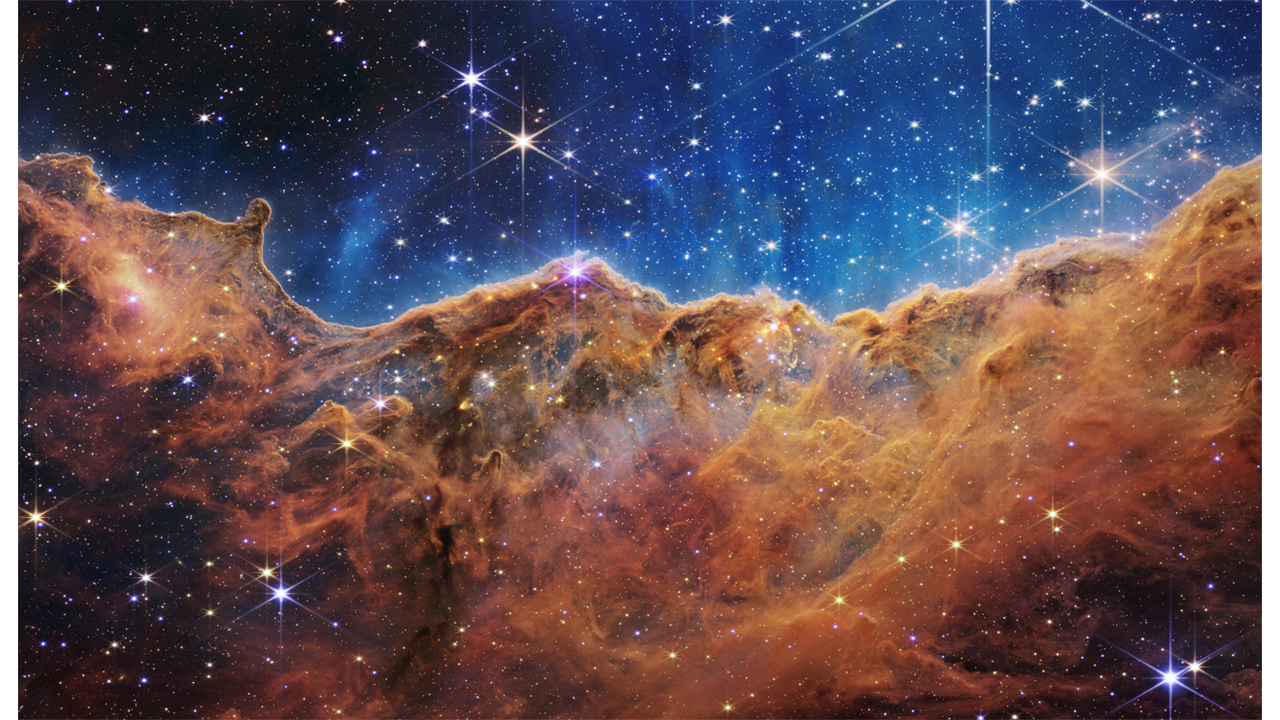The three-dimensional “Cosmic Cliffs” exhibit Webb’s ability to look through dust and provide new information about the formation of stars. At the northwest corner of the Carina Nebula, this scene of “mountains” and “valleys” is actually the boundary of a nearby stellar nursery known as NGC 3324.

“Cosmic Cliffs” in the Carina Nebula (Near-Infrared Camera Image). Image Credit: NASA, ESA, CSA, STScI.
Strong ultraviolet radiation and stellar winds from very big, hot, young stars positioned above the region seen in this photograph have cut a cavernous portion of the nebula. These stars’ blistering ultraviolet radiation is steadily eating away the nebula’s wall, gradually shaping it.
Dramatic pillars that are resistant to this radiation rise above the blazing gas wall. Heated, ionized gas and hot dust are flowing out from the nebula as a result of the unrelenting radiation, giving the appearance of “steam” rising from the celestial “mountains.”
It is challenging to image objects at the earliest, fastest stages of star formation, but Webb’s exceptional sensitivity, spatial resolution, and imaging capabilities can record these elusive occurrences.
The fringe of the neighboring, young star-forming area NGC 3324 in the Carina Nebula may be seen in this landscape of “mountains” and “valleys,” which are dotted with sparkling stars. This image, which was taken by NASA’s brand-new James Webb Space Telescope in infrared light, for the first time makes apparent previously hidden zones of star formation.
The largest “peaks” in this picture are really the edge of the enormous, gaseous cavity of NGC 3324, which is around seven light-years away. Intense ultraviolet radiation and stellar winds from very large, warm, young stars situated in the heart of the bubble, above the region seen in this view, have carved the cavernous area from the nebula.
Some of these newborn stars release protostellar jets, which are clearly seen in this picture, into space. In the pitch-black, dusty portion of the cloud, the newest sources are visible as red dots.
The star formation process will be clarified by these studies of NGC 3324. Star birth spreads throughout time as a result of the cavity’s erosion expanding. The bright, ionized ring steadily pushes into the gas and dust of the nebula. The increasing pressure will cause any unstable material that the rim comes in contact with to collapse and create new stars.
On the other hand, since the star-forming material is being stripped away, this sort of perturbation may potentially stop stars from forming. The balance between starting star formation and halting is very delicate. Some of the major, unresolved issues in contemporary astrophysics that Webb will address include: What controls how many stars develop in a certain area? Why do stars of a certain mass form?
Webb will also show how the development of enormous clouds of gas and dust is influenced by star formation. While the impact of large stars—which have ferocious winds and enormous energies—is often noticeable, less is known about the impact of low-mass stars, which are more prevalent.
These smaller stars produce the narrow, opposing jets shown here as they develop, which may add a lot of energy and velocity to the clouds. As a result, less nebular material is used to create new stars.
Scientists now know very little about the impact of the abundance of young, more energized low-mass stars. Researchers will be able to count all of them and determine their influence on the nebula, thanks to Webb.
NGC 3324 was photographed by Webb’s Near-Infrared Camera (NIRCam) and Mid-Infrared Instrument at a distance of around 7,600 light-years (MIRI).
With its sharp resolution and unmatched sensitivity, NIRCam reveals a large number of background galaxies as well as hundreds of previously unknown stars.
In the mid-infrared, newborn stars and their dusty planet-forming disks glow strongly, looking pink and red from MIRI’s perspective. Massive jets and outflows have stellar origins that are shown by MIRI, which also exposes structures hidden in the dust. The surface of the ridges glows under MIRI due to the heated dust, hydrocarbons, and other chemical substances that give them the appearance of jagged rocks.
James Dunlop initially categorized NGC 3324 in 1826. It is situated on the northwest edge of the Carina Nebula (NGC 3372), which is in the constellation Carina and is visible from the Southern Hemisphere. The Keyhole Nebula and the active, insecure supergiant star Eta Carinae are both found in the Carina Nebula.
In addition to looking beyond the solar system to distant planets orbiting other stars, Webb will probe into the intriguing architecture and origins of the cosmos and the human role within it. NASA is the driving force behind the Webb initiative, which also includes the Canadian Space Agency and the ESA (European Space Agency) as partners.
The mission is managed by NASA Headquarters on behalf of the Science Mission Directorate. Webb is managed by NASA’s Goddard Space Flight Center in Greenbelt, Maryland, which also coordinates work on the project by Northrop Grumman, the Space Telescope Science Institute, and other mission partners.
Several NASA sites, including the agency’s Johnson Space Center in Houston, Jet Propulsion Laboratory in Southern California, Marshall Space Flight Center in Huntsville, Alabama, and Ames Research Center in California’s Silicon Valley, among others, also participated in the project.